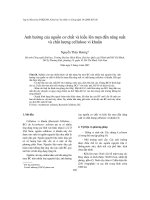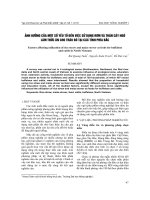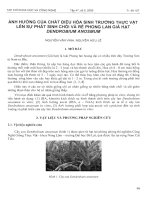Báo cáo " ảnh hưởng của các chất điều hoà sinh trưởng thực vật lên sự phát sinh hình thái của mẫu cây lát mỏng tế bào cuống chồi hoa súp lơ " pot
Bạn đang xem bản rút gọn của tài liệu. Xem và tải ngay bản đầy đủ của tài liệu tại đây (348.35 KB, 5 trang )
Tgp chi Cdng nghi Sinh hpc 1(1): 119-133, 2009
EFFECTS OF PLANT GROWTH REGULATORS ON THE MORPHOGENESIS OF
CAULIFLOWER CURD TRANSVERSE THIN CELL LAYER EXPLANTS
Duong Tan
Nhut',
Bui Van The
Vinb^
'Tay Nguyen Institute
of
Biology
^University
of Technology, Ho Chi Minh City '
'''
SUMMARY
-
1.
/ii'-'
•'• i
Transverse thin cell layers (tTCLs) from mature curd of Cauliflower
(Brassica oleracea
var.
botrytis)
were
cultured on Murashige and Skoog medium supplemented with different types of plant growth regulators
(PGRs) at various concenfrations. The results were recorded after 6 weeks of culture. The presence of 2,4-
dichlorophenoxy-acetic acid (2,4-D) at 0.1 - 1.0 mg 1"' resulted in callus formation, while roots formed in
culture medium supplemented with 0.5 - 1.0 mg 1"' NAA (naphthalene acetic acid). When l-phenyl-3-(l,2,3-
thiadiazol-5-yl)-urea (TDZ) was added to culture medium at 0.2 - 0.6 mg
1"',
shoot clusters regenerated directly
from the edge of explants. Shoots initiated in the presence of TDZ, but without stem elongation and leaf
formation. In order to obtain normal plant development, clumps of regenerated shoots were fransferred onto
PGR-free MS medium. Approximately 26 shoots with normal stem elongation developed from each tTCL after
2 weeks. Rootmg was obtained by fransferring shoots to MS medium supplemented with 0.4 mg 1"' NAA and
0.2 mg
r'
Kinetin. Regenerated plants with adventitious roots were fransferred to soil. The results
demonsfrated that the choice of
PGRs
is of significance in determining the morphogenesis of cauliflower curd
tTCL explants.
Keywords:
Brassica oleracea
var.
botrytis,
curd,
TCL,
morphogenesis,
PGRs
INTRODUCTION
is one of the most important
in the world because of their
According to
th&
United States
Cauliflower
vegetable crops
nutritious value.
Department of Agriculture,
100
g of raw cauliflower
provides 77% of an adult's Dietary Reference
Intakes (DRI) of vitamin C. It is also a source of
dietary fiber, vitamin B6, folate, pantothenic acid, as
well as small amounts of other vitamins and
minerals.
The low price of cauliflower seeds has
resfricted
the use of clonal multiplication for breeding
purposes on this important crop. Previous studies on
in vitro propagation of cauliflower are limited to
seedling explants (Vandemoortele et al, 1993; Dash
et al, 1995; Arora et al, 1996; 1997), protoplast
culture (Delpierre, Boccon-Gibod, 1992; Yang et al,
1994) and anther
cultiire
(Yang et al, 1992). Other
different explants from vegetative (including stem,
petiole,
leaf,
leaf rib) and floral (including peduncle,
pedicel, flower bud and curd) tissues of cauliflower
were also used for in vitro propagation (Prem,
Nicole, 1999).
Our previous research reported that "thin cell
layer" explants from the surface of floral branches of
tobacco could be induced to form either callus,
vegetative buds, flowers or roots by adjusting the pH
and the ratio of auxin to cytokinin in the culture
medium (Nhut et al, 2001). In this paper, we
describe the morphogenesis of cauliflower curd
fransverse thin cell layers in culture medium
supplemented with different types of PGRs.
MATERIALS AND METHODS
Plant materials
Mature curds (approximately 20 - 25 cm in
diameter) were collected from field. These curds
were sliced into small pieces. Each curd piece was
washed thoroughly under
ruimuig
tap water for 30
min, soaked in detergent (Viso, Dongnai, Vietnam)
for 5 min, rinsed 6 times with distilled water and
then with ethanol (10%) for 30 s. After three rinses
with distilled water, the small piece of curd were
disinfected with 0.1 %
HgCl2
for 6 mins, and rinsed
6 times in sterile distilled water. These curds were
cut into rounds (1 mm thickness fransverse slices)
(Figure 1).
Media and experimental conditions
TCLs were placed on MS medium (Murashige,
229
Skoog,
1962)
containmg 30 g
l'
sucrose, 8 g
1"'
agar
and 2,4-D (0.1, 0.5 or 1.0 mg 1"'), NAA (0.1, 0.5 or
1.0 mg 1') or TDZ (0.2, 0.4, 0.6, 0.8 or 1.0 mg 1"').
In all experiments, culture media were dispensed
into culture vessels (250 ml), each containing 30 ml
medium and capped with a tiansparent
polypropylene film. Culture media were adjusted to
pH 5.8 before autoclaving at
121°C
for 20 min. All
cultures were incubated at 25 ± 1
°C
with a
photoperiod of
Id**
per day at a light intensity of 40
pmol
m'^
s"'
fluorescent light. Data were recorded
after 45 days culture. The data was analyzed for
significance by analysis of variance with mean
separation by Duncan's multiple range test.
RESULTS AND DISCUSSION
In this study, a protocol was developed for
confrolling the type of morphogenesis that occurs in
cauliflower mature curd explants when cultured on
media with different types of PGRs. Each of PGRs
stimulated distinct morphogenetic pathways. These
PGRs were shown to stimulate the direct formation
of tissues or organs such as shoots, roots or
calli
depending on the medium on which tTCLs were
cultured (Figure 2).
tTCL explants of cauliflower curd in
PGR-firee
MS
medium enlarged
significantiy
after 7-8 days
culture. These explants, however, turned brown and
became necrotic after 4 weeks culture. These results
were also consistent with the report on the
Duong Tan Nhut & Bui Van The Vinh
morphogenetic capacity of TCL explants of sugar
beet, which was stiongly dependent on the presence
of
PGRs
in the medium
(Dettez
et al, 1988).
Effect of 2,4-D on callus formation
Callus from tTCL explants of cauliflower curd
showed enhanced growth on the medium
supplemented with 2,4-D at different concentiations.
tTCL explants cultured in medium supplemented
with 1.0 mg
r'
2,4-D produced callus with the
highest frequency (Table 1). In the presence of 2,4-D
at lower concenfrations, few calli turned brown and
necrosis. Browning callus percentages at the
concenfrations of
0.1
and 0.5 mg
P'
are 6.7%) and
3.3%,
respectively.
Callus formation may be due to the ratio of
cytokinin to auxin as mentioned by Skoog and Miller
(1957) and Caspar et al (2003). In the present
research, primary callus was fiiable, globular and
yellowish-white by utilizing different concentrations
of 2,4-D (Table 1, Figure 2a). These calli
subsequently gave rise to different kinds of callus
when continuously proliferated in the same medium.
Effect of
NAA
on root formation
Experiments on different NAA concentiations
revealed that high frequencies of root organogenesis
occurred at 0.5 - 1 mg
l'
NAA (100%)), but primary
root number, primary and adventitious root length on
medium supplemented with 0.5 mg 1"' NAA were
higher than other media (Table 2).
Table 1. Effect of 2,4-D on caiius formation of cauiiflower curd tTCL explants.
2,4-D concentrations (mg
1'^)
Callus formation rate (%) Callus fresh weight (g)
0.5
10
93.3
96.7
100
0.97°
1.25'
1.02"
Different letters within a
coiumn
indicate signiflcant differences at a = 0.05 by Duncan's multiple range test.
Table 2. Effect of NAA on root formation of cauiiflower curd tTCL explants.
NAA concentrations (mg i") Root formation rate (%) Root length (mm) Number of roots
0.1
lo'
'
94.4
100
100
15.2"
21.8'
18.3'=
15.3"
16.7'
15.0"
Different letters within a coiumn indicate significant differences at a = 0.05 by Duncan's multiple range test.
230
Tgp chi
Cong
nghe Sinh hpc
1(2):
229-233,
2009
"iiM,.
vy
curd part
5-1.0
mm
Isolate tTCL
>-
•^
'y^
Transfer
planlets
to greenhouse
—^
Inocubate under
culture condition
Transfer shoot clusters
onto PGR-free medium
Transfer shoots onto
root-induce medium
<
Figure 1. Diagram of cauiiflower morphological pathway by using transverse thin cell layer technology.
Figure 2. Callus (a), root (b), shoot (c,
Ci,
C2),
induction from curd tTCL of cauiiflower; piantiet formation (d), and ex vitro
performance (e).
231
Duong Tan Nhut & Bui Van The Vinh
Effect of TDZ on shoot formation
For TDZ, bud primordia were initiated on
100%)
tTCL explants with the concentiations ranging from
0.2 - 0.6 mg
r'.
An average of 26 bud primordia per
tTCL was obtained at 0.6 mg
1"'
of TDZ (Table 3).
At higher concenfrations of TDZ, bud primordia
formed but their further development was reduced.
In order to obtain normal plant development, clumps
of regenerated shoots were transferred onto PGR-
free MS medium.
The effect of TDZ as
cytokinin-like
substances
(Mok et al, 1987), as well as their effect on shoot
regeneration in in vitro cultures (Hosokawa et al,
1996) were demonstiated. Other authors have also
reported TDZ effect on organogenesis of peanut
embryo sections and hypocotyl (Saxena et al, 1992)
and on Geranium seedlings (Gill et al, 1993). In this
research, we obtained high bud regenerative
frequency by employing tTCL method combining
with the ultilization of TDZ on Brassica oleracea
var. botrytis.
Table 3. Effect of TDZ on shoot regeneration of cauiiflower curd tTCL explants.
TDZ concentrations (mg I') Shoot regeneration rate (%) Fresh weight of shoot Number of shoot per tTCL
clusters (g) expiant
0.4
0.6
0.8
1.0
0.2
100
100
100
96.4
84.2
2.28"
2.53"
2.62'
2.47"
2.21"
22"
23"
26^
20°
19°
Different letters within a column indicate significant differences at a = 0.05 by Duncan's multiple range test.
CONCLUSION
In this study, by using tTCLs (1 mm thickness)
and various types of plant
growth
regulators, a
simple and highly effective method for successfully
programming morphogenesis for callus, root, and
shoot formation was achieved. The addition of
selected auxins and cytokinins to the culture medium
and the size of expiant improved the specificity of
morphogenesis. It was demonstrated that tTCL was
an expiant source, which was very sensitive to the
presence of plant growth regulators in the medium
and this has not been observed when other
cauliflower tissues or organs were used.
Acknowledgement: The authors wish to thank Plant
Molecular Biology and Plant Breeding Department
for their supports.
REFERENCES
Arora N, Yadav NR, Chowdhury JB (1996) Efficient plant
regeneration in cauliflower (Brassica oleracea var.
botrytis).
Cruciferae Ne-wsl
18:
26-27.
Arora N, Yadav NR, Yadav RC, Chowdhury JB,
Ajora
N
(1997)
Role of
lAA
and BAP on plant regeneration in
cultured cotyledons of cauliflower. Cruciferae
Ne-wsl
19:
41-42.
Dash P, Sharma RP, Kumar PA (1995) Shoot regeneration
in the genotypes of
cauliflower.
Cruciferae Newsl
17:
26-27.
Delpierre N, Boccon-Gibod J (1992) An extensive hairy
root production precedes shoot regeneration in protoplast-
derived calli of cauliflower (Brassica oleracea var.
botrytis).
Plant
Cell
Rep
11:
351-354.
Defrez C, Tetu T, Sangwan RS, Sangwan-Norreel BS
(19,88) Direct organogenesis from petiole and thin cell
layer explants in sugar beet cultured in
vitro.
J Exp Bot 39:
917-926.
Caspar T, Kevers C, Faivre-Rampant O, Creve-Coeur M,
Penel
C, Greppin H, Dommes J (2003) Changing concepts
in plant hormone action. In vitro Cell Dev Biol Plant 39:
85-106.
Gill R, Gerrath JM, Saxena P (1993) High-frequency
direct somatic embryogenesis in thin layer cultures of
hybrid seed geranium (Pelargonium
x
hortorum). Can J
5or
71:
408-413.
Hosokawa K, Nakano M, Oikawa Y, Yamamura S
(1996)
Adventitious shoot regeneration from
leaf,
stem and root
explants of commercial cultivars
Gentiana.
Plant
Cell
Rep
15:
578-581.
Mok MC, Mok DWS, Turner JE, Mujer CV (1987)
Biological and biochemical effects of cytokinin active
phenylurea derivatives in tissue culture system. Hort
Science
22:
1194-1197.
232
Tgp chi Cdng nghi Sinh hpc 1(1):
229-233,
2009
Murashige T, Skoog F
(1962)
A revised medium for rapid Skoog F, Miller CO (1957) Chemical regulation of growth
growth and bio-assay with tobaco tissue cultures. Physiol and organ formation in plant tissue
cultares
in vitro. Symp
Plant
15:
473-479. Soc Exp Biol
11:118-131.
Nhut DT, Bui VL, Tran TVK (2001) Manipulation of the Vandemoortele JL, Billard JP, Boucaud J, Caspar T (1993)
morphogenetic pathways
of
Xj/wm/o«g//Zon<»!
fransverse Effect of osmolarity and medium composition on
thin cell layer explants by auxin and cytokinin, In vitro callogenesis, caulogenesis and rhizogenesis of Brassica
Cell
Dev Biol Plant
37-
44-49 oleracea L. var. botrytis hypocotyl fragments. Biol Plant
35:
17-24.
Prem LB, Nicole DW (1999) In vitro propagation of
^ _
„,
•
^o -c
v/,nm^
A
*,
J
re .
cauhflower, Brassica oleracea var.
^,or^«/for
hybrid seed
^^^ .^' ^hauvm
JE, Herve Y
(1992)
A study of factors
production. Plant Cell Tiss Org Cult
56:
89-95.
^^^^f "8 ^"*^'', '^''^^'l"^
cauliflower (Brassica oleracea
^ *
var.
botrytis).
Plant Cell Tiss Org Cut
28:
289-296.
Saxena PK, Malik KA, Gill R (1992) Induction by yang ZN, Xu ZH, Wei ZM (1994) Cauliflower
thidiazuron
of somatic embryogenesis m intact seedlings inflorescence protoplast culture and plant
regeneration,
of peanut. Planta 187: 421-424.
p;^„^
Ce//
Tiss Org Cult
36:
191-195.
ANH
HU^OnVG
CUA CAC CHAT DIEU HOA SINH
TRl/OfNG
THTTC
VAT
LEN SlT PHAT
SINH
HINH THAI
CUA
MAU
CAY
LAT
MONG
TE
BAO
CUONG
CHOI
HOA SUP LO
Duong TSn
Nhut''*,
Biii Van
Tbi
Vinb^
' Viin Sinh hpc Tdy Nguyin
Trudng Dgi hpc Ky thugt Cdng nghe, thdnh phd Hd Chi Minh
TOM TAT
Cac mau cay lat mdng te bao cat ngang (tTCL) tit cudng choi hoa cua cay Siip la
(Brassica
oleracea var.
botrytis)
duac nudi cay fren mdi tnrdng MS bd sung cac chat dieu hda sinh trudng thuc vat d nhimg ndng do
khac nhau. Ket qua duac ghi nhan sau 6 tuan nudi cay. Su Men dien cua
2,4-dichlorophenoxy-acetic
acid (2,4-
D) d ndng do 0,1 - 1,0 mg/l cam
iing
su hinh thanh md seo frong khi re
dugc
cam ung fren mdi trudng cd bd
sung 0,5 - 1,0 mg/l NAA (naphthalene acetic acid). Khi l-phenyl-3-(l,2,3-thiadiazol-5-yl)-urea (TDZ) dugc bd
sung vao mdi tnrdng nudi cay d ndng dp 0,2 - 0,6 mg/l, cac cum choi dugc hinh thanh tu ria cua mau cay. Tuy
nhien,
ehdi
dugc tao thanh fren mdi trudng cd TDZ khdng cd su phat trien keo dai than va hinh thanh la. De
thu nhan cay con phat trien hoan chinh, nhiing cum
ehdi
nay phai dugc chuyen sang mdi trudng khdng cd chat
dieu hda sinh trudng thuc vat. Khoang 26 choi phat trien binh thudng
tii
mdi mau cay tTCL sau 2 tuan nudi
cay. Nhiing choi khde manh dugc chuyen sang mdi trudng MS cd bd sung 0,4 mg/l NAA ket hgp vdi 0,2 mg/l
Kinetin de kich thich ra
re.
Ket qua nghien
ciiu
da chi ra rang viec lua chon cac chat dieu hda sinh trudng thuc
vat la yeu td chinh xac dinh dang dap
iing
phat sinh hinh thai cua mau cay tTCL tir cudng choi hoa Slip la.
Tif khoa:
Brassica oleracea
var.
botrytis,
cuong choi
hoa,
TCL,
phdt
sinh
hinh
thdi,
PGRs
' Author for correspondence: Tel: 84-63-3831056; Fax: 84-63-3831028; E-mail:
duonstannhut&gmail.
corn
J J.J









